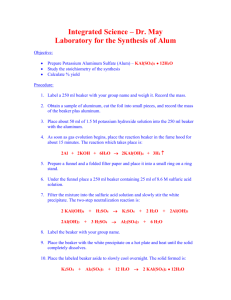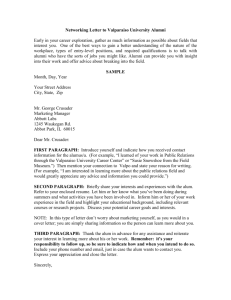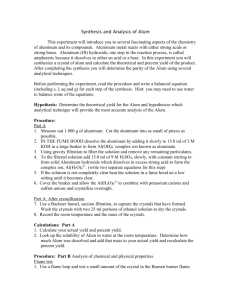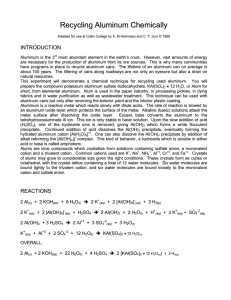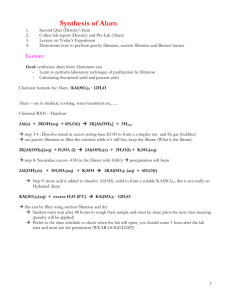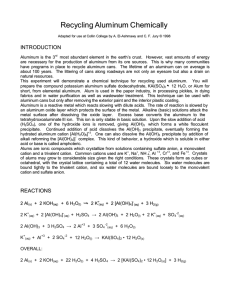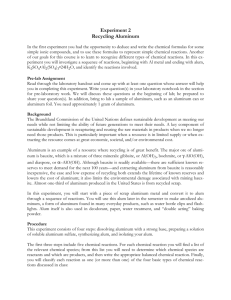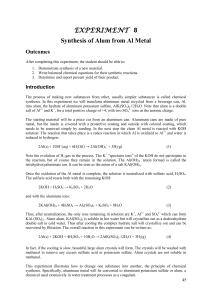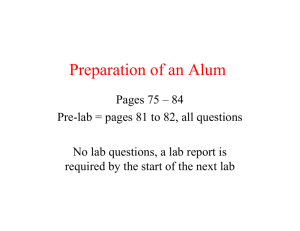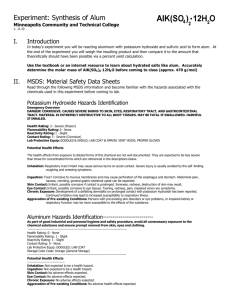Recycling Aluminum - DePauw University
advertisement
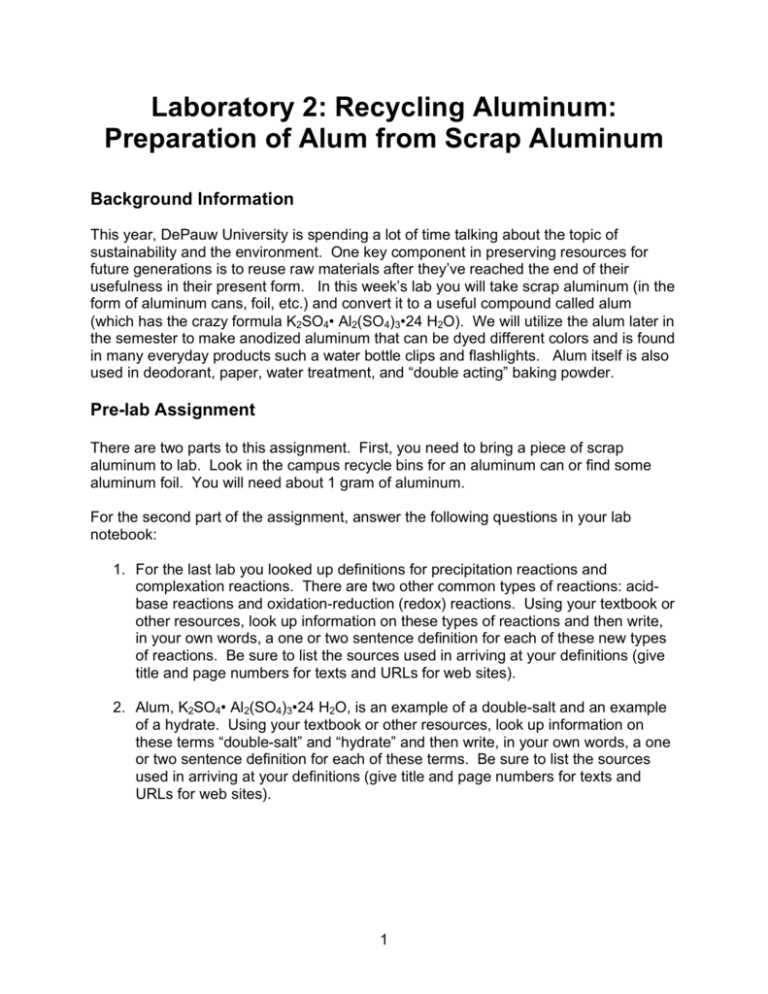
Laboratory 2: Recycling Aluminum: Preparation of Alum from Scrap Aluminum Background Information This year, DePauw University is spending a lot of time talking about the topic of sustainability and the environment. One key component in preserving resources for future generations is to reuse raw materials after they’ve reached the end of their usefulness in their present form. In this week’s lab you will take scrap aluminum (in the form of aluminum cans, foil, etc.) and convert it to a useful compound called alum (which has the crazy formula K2SO4• Al2(SO4)3•24 H2O). We will utilize the alum later in the semester to make anodized aluminum that can be dyed different colors and is found in many everyday products such a water bottle clips and flashlights. Alum itself is also used in deodorant, paper, water treatment, and “double acting” baking powder. Pre-lab Assignment There are two parts to this assignment. First, you need to bring a piece of scrap aluminum to lab. Look in the campus recycle bins for an aluminum can or find some aluminum foil. You will need about 1 gram of aluminum. For the second part of the assignment, answer the following questions in your lab notebook: 1. For the last lab you looked up definitions for precipitation reactions and complexation reactions. There are two other common types of reactions: acidbase reactions and oxidation-reduction (redox) reactions. Using your textbook or other resources, look up information on these types of reactions and then write, in your own words, a one or two sentence definition for each of these new types of reactions. Be sure to list the sources used in arriving at your definitions (give title and page numbers for texts and URLs for web sites). 2. Alum, K2SO4• Al2(SO4)3•24 H2O, is an example of a double-salt and an example of a hydrate. Using your textbook or other resources, look up information on these terms “double-salt” and “hydrate” and then write, in your own words, a one or two sentence definition for each of these terms. Be sure to list the sources used in arriving at your definitions (give title and page numbers for texts and URLs for web sites). 1 Experimental Procedure As you go through this experiment, always be thinking ahead to the next step of the reaction. What reagents or equipment will you need to carry out the next step? There is a lot of waiting as the different reactions occur, so take advantage of the time by gathering together equipment and writing in your notebook while you are waiting. As you carry out the experiment, describe the chemical reactions in your notebooks, including the color of solutions and precipitates, and other noteworthy information. For each step you will find a list of the molecules and ions that are involved (with the exception of water, which you can always add as a reactant or product as needed). Based on your observations, identify in your lab notebook those species that are reactants and those that are products and indicate the physical state of each using (s) for solids, (aq) for species dissolved in solution, (g) for gases and (l) for liquids. Be sure to explain the reason(s) for your assignments of reactants and products. Step 1. Relevant Chemicals: H2, Al(OH)4–, Al, KOH, K+ Weigh a 1 gram (+/- 0.1 g) piece of scrap aluminum, recording in your lab notebook the weight to the nearest milligram. If your sample is too large, use the scissors to cut your sample to the required size; if your sample is too small then add another piece of scrap aluminum. !!!!!Caution!!!!! Because hydrogen, which is a potentially explosive gas, is involved in this reaction, the first part of this step must be completed in a hood. Once you begin the reaction, do not remove it from the hood until the reaction is complete. IN THE HOOD: Lightly “scrunch” the aluminum so that it will not simply float on top of the liquid, and place it in a 250 mL beaker. Add 15 mL of 6 M potassium hydroxide. Cover the beaker with a watch glass. Place the beaker on a hot plate and heat gradually starting at a moderate setting (do not turn the heat up all the way!). Watch the solution carefully, and as soon as it starts to foam vigorously, add 35 mL of deionized H2O. Note the volume of this liquid, and use your water wash bottle to maintain this volume while it heats. Do not add excessive water as it will dilute the base too much. Continue heating until the metal is no longer visible, and the evolution of gas has stopped. Check this by carefully removing the beaker from the hot plate (using a heat resistant glove or paper towels to protect your hands), placing it on a white sheet of paper, and gently swirling. If foam appears on the surface of the liquid, it is still evolving gas, and needs to be heated longer. Depending on your source of aluminum, there may be fine black particles suspended in the liquid at this point; this is from a coating on your scrap metal piece and will be removed by filtering. WHEN THE REACTION IS FINISHED YOU CAN REMOVE IT FROM THE HOOD AND CONTINUE. 2 Prepare a piece of large filter paper by folding it into quarters. Insert the paper wedge into a funnel and separate the layers so that the filter paper completely covers the inside of the funnel (three layers will be on one side and one on the other). If you filter paper does not completely fit within the funnel, check out a larger funnel from the stockroom. Wet the paper with a small amount of distilled water (this creates a tight seal between the paper and the funnel and prevents the solid from going over the side of the paper and into the liquid below!). Place the funnel over a 250 mL beaker that will serve as a collection vessel for your filtrate. While the liquid is still hot, pour it into the funnel to filter the hot liquid. Rinse the reaction vessel with two portions of about 3 mL of deionized water and pour that through the filter as well. Step 2. Relevant Chemicals: H2SO4, K2SO4, KOH Measure out 35 mL of 6 M sulfuric acid into a small flask. While continuously stirring your solution from Step 1, slowly add 1-2 mL of acid. Step 3. Relevant Chemicals: Al(OH)3, H2SO4, Al(OH)4– , SO42Continue to slowly adding the sulfuric acid until you see a precipitate form. Step 4. Relevant Chemicals: Al(OH)3, Al2(SO4)3, H2SO4 Now place the beaker on a hot plate and heat the solution while adding still more of the sulfuric acid. Allow the solution to warm until it just starts to steam. If your solid fails to completely dissolve after adding all of your acid and allowing it to react for several minutes, then add an additional 2 mL of acid and heat a bit longer. Step 5. Relevant Chemicals: K2SO4, K2SO4•Al2(SO4)3•24H2O, Al2(SO4)3 Make an ice bath in a 600 or 800 mL beaker using water and ice. Place your reaction vessel from Step 4 in the ice bath, and allow the solution to drop to 5˚C or lower. The final product, alum, will appear on the bottom of your beaker as a very fine, sandy, white layer. If crystals do not form, scratch the bottom of the beaker with a glass stirring rod. (Note: While you are cooling your solution, also place 10 mL methanol in a small flask and begin cooling it in the ice bath for a later step.) Quantitatively transfer the alum to a Buchner funnel set up on a vacuum apparatus as shown to the right. Check with your instructor before proceeding to make sure you have set it up correctly. Pour the liquid through the filter paper, and then use a spatula to transfer most of the crystals to the filter paper. You cannot 3 filter paper (do not fold!) to aspirator add any water at this point or you will dissolve your alum. Instead, once you have suctioned off the liquid, break the vacuum by removing the hose on the side arm of your flask, open the filtration flask and pour the filtrate into a small clean beaker. Resume the vacuum and use the filtrate to wash any remaining alum crystals in your breaker onto the filter, using many small rinses instead of just one. Your alum is still a bit wet at this point. To help remove some of the water, slowly rinse the crystals with 10 mL of COLD methanol while continuing to apply suction. use a disposable pipette to add the methanol and ensure that you rinse all of your alum. (NOTE: When methanol hits the filtrate in the filtration flask, it will form crystals of excess K2SO4, not alum! Discard this, and do not pour it back over the alum!) Transfer the Alum and Allow it to Dry Quantitatively transfer the alum onto a watch glass. Use your spatula to gently scrape it free from the filter paper. Allow it to dry in the bottom cabinet of your lab drawer until the next lab period, when you will obtain its mass. Be sure to record this mass in your lab notebook. Mass Percent Water of Alum Sample Since alum is a hydrated salt, the hydrated water molecules contribute to its overall mass. After all of the excess water that is not part of the crystal has evaporated, we can determine how much water is part of the structure of the crystal (hydrate water) by heating the alum in an oven. Transfer about 1 g (+/- 200 mg) of your alum to a labeled watchglass and weigh it to the nearest milligram. Label your sample and place it in the lab’s oven (which is at 110 °C). After 48 hours, remove your sample using the heat resistant gloves provided, allow it to cool to room temperature and reweigh your sample to see how much of the weight has been lost. Save the rest of your unheated alum in your drawer until October when we will use it again for another laboratory. Waste Disposal Dispose of all waste into the container provided in the hood. Lab Report Complete the worksheet provided by your instructor. References This laboratory is adapted from a version developed by Deberah Simon of Whitman College. 4

